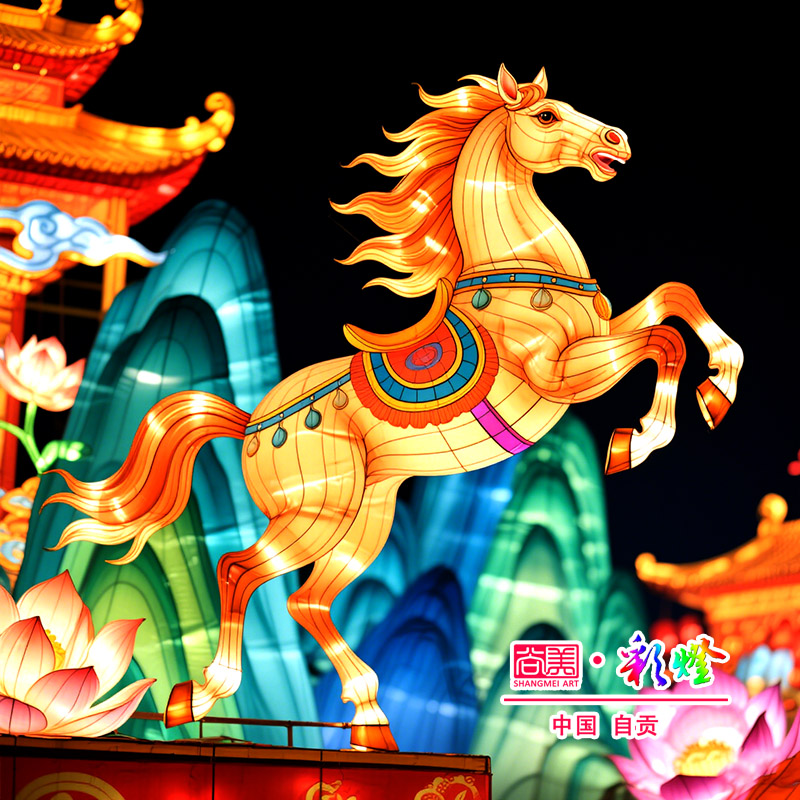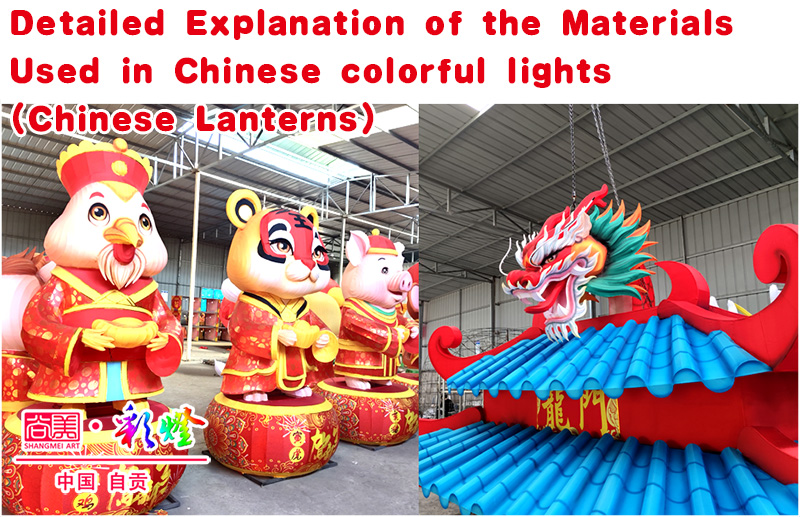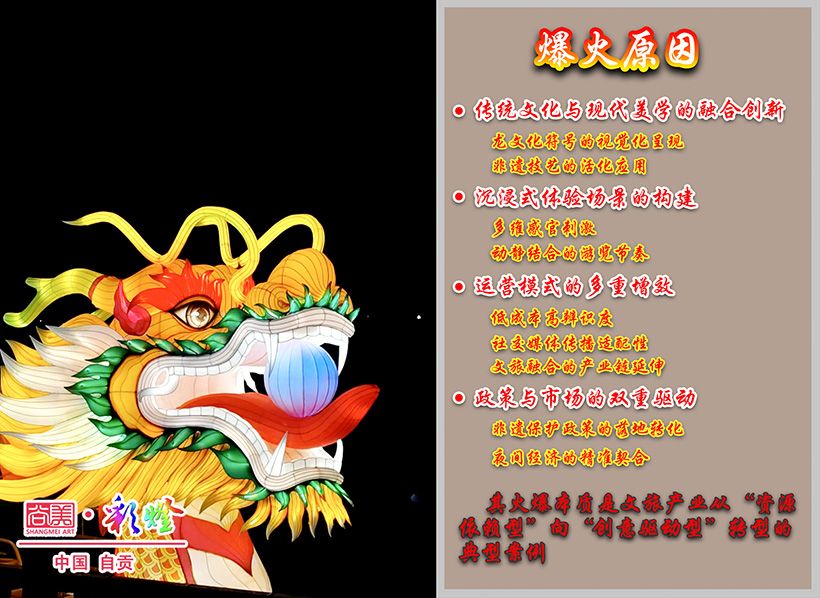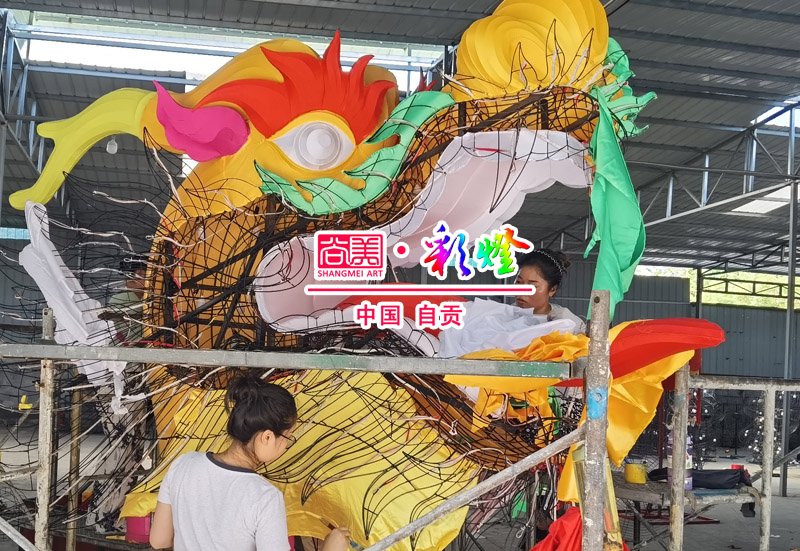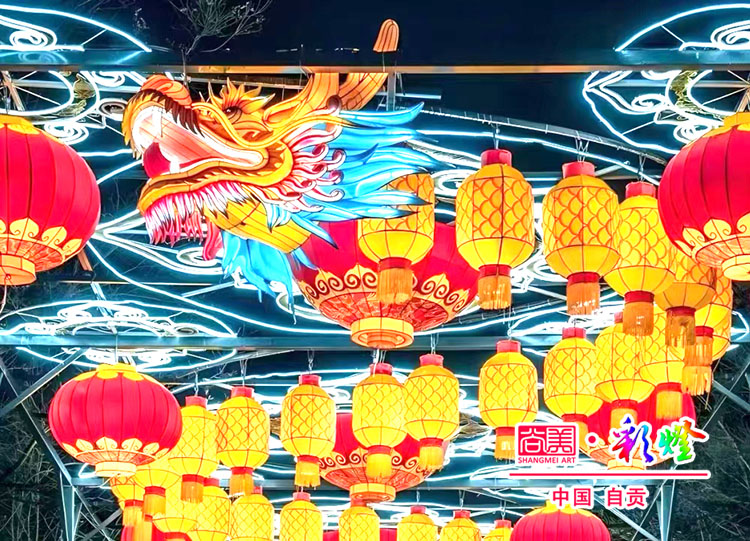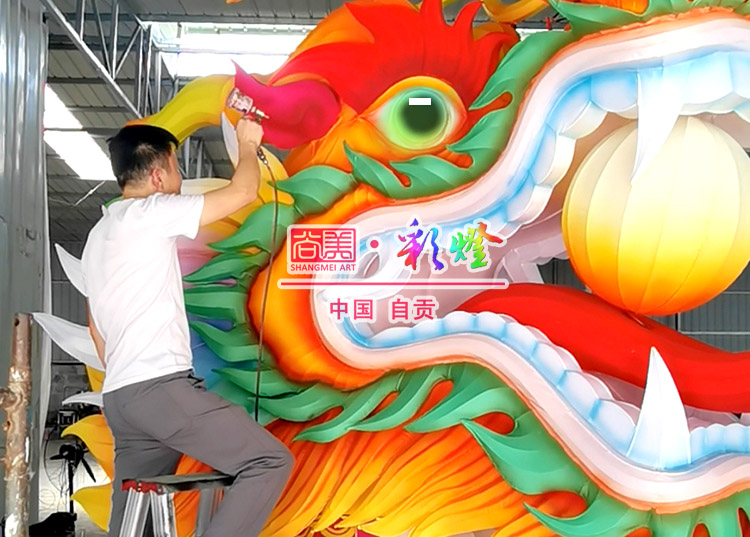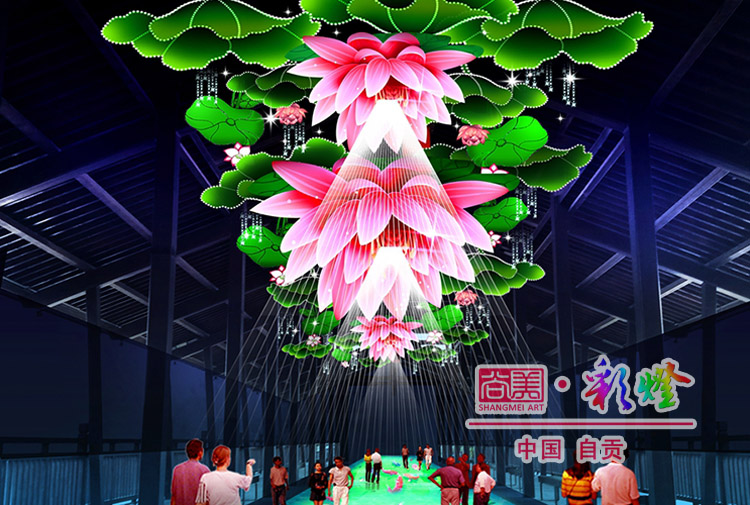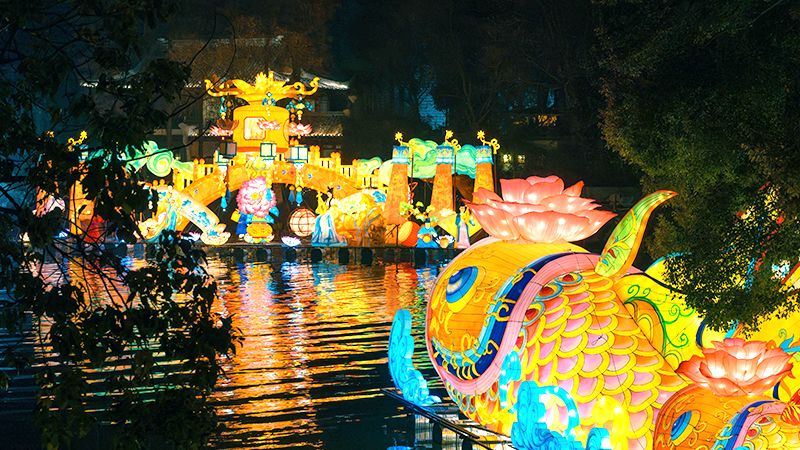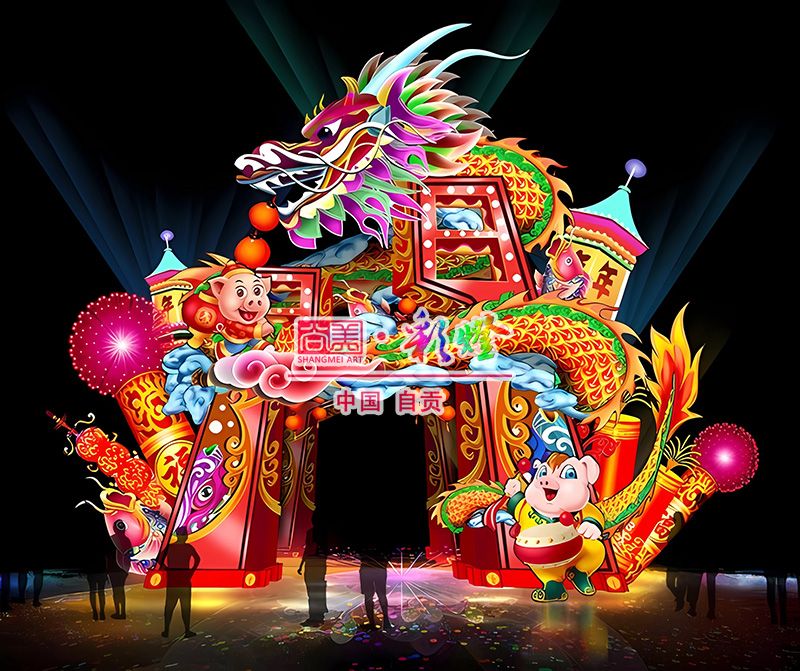
Chinese lanterns, also known as Chinese colored lanterns, have a long and rich history, accompanying the development of most of the Chinese civilization. The earliest written records can be traced back to the Han Dynasty, when practical lighting gradually transitioned to decorative and celebratory items, eventually becoming festive lighting and folk cultural products, occupying a prominent position in traditional Chinese culture. Normally, Chinese colored lanterns (lanterns) will appear in traditional festivals such as Yuanxiao (Filled round balls made of glutinous rice-flour for Lantern Festival) Festival, Qixi Festival, Mid-Autumn Festival, National Day and Spring Festival. There are many places of origin for Chinese lanterns (lanterns), such as Zigong in Sichuan, Foshan in Guangdong, Taiyuan in Shanxi, Kaifeng in Henan, and Weifang in Shandong. However, the lanterns (lanterns) from Zigong in Sichuan are still the most mature in terms of industrial development, advanced in lantern (lantern) production technology, and have a large number of employees. They hold a leading position in the industry and account for 95% of the world's lantern (lantern) output value. There is a saying that goes' the world's lanterns look at China, and China's lanterns look at Zigong 'and' Zigong comes back without looking at the lanterns', both showcasing the reputation of Zigong's lanterns as the best in the world.
The Development History of Chinese Lantern (Colored Lanterns)
The development history of Chinese lanterns is long and rich, dating back to ancient times. Here are some major historical nodes:
Ancient origin: The origin of colored lanterns can be traced back to ancient Chinese sacrificial and religious activities. During the Warring States period in the states of Chu and Han, colored lanterns began to appear as decorations for religion and festivals, mainly used for praying for blessings and exorcising evil spirits.
During the Han and Tang dynasties, colorful lanterns gradually became an important element in festivals and royal celebrations. Especially in the "Yuanxiao (Filled round balls made of glutinous rice-flour for Lantern Festival) Festival" of the Han Dynasty, colored lanterns began to appear as decorations for the festival. In the Tang Dynasty, this custom was further developed, and the scale and patterns of the lantern festival became more abundant.
During the Song and Yuan dynasties, there was a significant improvement in the production technology and design level of colored lanterns. The materials and craftsmanship of lanterns have become more diverse, and their shapes and patterns have become more exquisite and complex. During this period, colored lanterns were not only used for festive celebrations, but also widely used in various folk celebrations and activities.
Ming and Qing Dynasties: During the Ming and Qing Dynasties, the lantern culture further flourished, especially in traditional festivals such as the Yuanxiao (Filled round balls made of glutinous rice-flour for Lantern Festival) Festival and the Mid-Autumn Festival. The production and exhibition of lantern became an important folk activity. During the Qing Dynasty, the "Lantern Festival" was even more grand, with a variety of colorful and uniquely shaped lantern displays from different regions.
The early Zigong Lantern Festival in Zigong Lantern Park is shown in the picture of 2008 Monument to the people's Liberation Lantern Group of the Lantern Park in modern times: after entering modern times, the Lantern not only maintains the traditional craft and form, but also integrates modern scientific and technological elements. For example, the application of electric lights and LED lights makes the display effect of colored lights more colorful. In addition, the application scope of colored lights has expanded from traditional festivals to various commercial activities and cultural festivals.
Overall, the development history of Chinese lanterns (lanterns) demonstrates rich cultural traditions and constantly evolving craftsmanship. It is not only an important symbol of traditional Chinese festivals, but also an important carrier for showcasing Chinese culture and art.

Chinese lanterns in Zigong
What festivals are Chinese lanterns usually used for?
Chinese lanterns are mainly used for the following important festivals and occasions, each with its own specific meaning and customs:
Yuanxiao (Filled round balls made of glutinous rice-flour for Lantern Festival):
Meaning: The Yuanxiao (Filled round balls made of glutinous rice-flour for Lantern Festival) Festival is the 15th day after the Spring Festival, which is also the traditional "Lantern Festival" in China. It marks the end of the Spring Festival and celebrates the arrival of spring. This festival is also called 'Shangyuan Festival'.
Customs: The main customs of the Yuanxiao (Filled round balls made of glutinous rice-flour for Lantern Festival) Festival are to enjoy the lanterns, eat Yuanxiao (Filled round balls made of glutinous rice-flour for Lantern Festival) (rice dumpling) and guess riddles. Colorful lights are widely used during this festival, usually featuring large displays with diverse shapes and themes, symbolizing reunion and celebration.
Mid- Autumn Festival
Meaning: Mid-Autumn Festival is a festival to celebrate harvest and reunion. It is on the 15th day of the eighth lunar month. This festival emphasizes family reunion and gratitude.
Customs: The common customs of Mid-Autumn Festival include appreciating the moon, eating moon cakes, carrying lanterns, etc. Especially children carry colorful lanterns of various shapes, which not only decorate the festive atmosphere but also symbolize brightness and happiness.
Spring Festival:
Meaning: Spring Festival is the most important traditional festival in China, marking the beginning of the Lunar New Year and a time to bid farewell to the old and welcome the new.
Customs: During the Spring Festival, people will decorate lanterns, hang lanterns, and set off fireworks and firecrackers to pray for a safe and smooth new year. The design of lantern decorations usually features auspicious patterns, symbolizing good wishes for the New Year.
Other festivals and celebrations:
Loong Boat Festival: Although the Loong Boat Festival mainly focuses on Loong Boat racing and eating Zongzi, in some areas there will also be colored lights to enhance the festival atmosphere.
Qixi Festival: It is the seventh day of July in the lunar calendar, which is also China's Valentine's Day. This day is the time when the cowherd and the Weaver Girl meet once a year.
Lantern Festival: In addition to the aforementioned festivals, various regions also hold specialized lantern festivals, such as those during the Spring Festival, showcasing various forms of lanterns to attract tourists and celebrate the festival.
Overall, the significance of colored lights in these festivals is not only for decoration and entertainment, but more importantly, they represent the atmosphere of the festival, traditional customs, and expectations for a better future life. Through the display of colorful lights, people can feel the festive and reunion atmosphere of the festival.
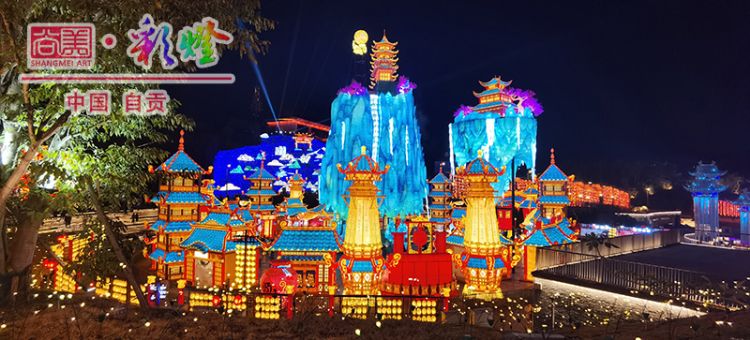
Chinese lanterns in Zigong
The main production areas of Chinese lanterns and the industry status of Zigong lanterns
There are many places in China famous for producing exquisite colored lights. Here are some of the main production areas and their characteristics:
The craftsmanship of Zigong lanterns has gradually replaced the traditional craftsmanship of Qinhuai lanterns, and the Qinhuai Lantern Festival still uses the Zigong lantern making team. Qinhuai Lantern Festival, also known as "Qinhuai Colored Lanterns" or "Nanjing Lantern Festival", is renowned as the "Number One Lantern Festival in the World" and "Qinhuai Lantern Festival is the best in the world". It is one of the important schools of traditional Chinese lantern art. It draws on the strengths of Chinese traditional art of paper binding, painting, calligraphy, Paper Cuttings, shadow puppets, embroidery, sculpture and so on. In its production, it comprehensively uses carpentry, lacquerwork, color painting, carving, clay sculpture, knitting and many other technological means, forming a unique technical feature. Every year around the Spring Festival, the Qinhuai River in Nanjing holds a grand "Qinhuai Lantern Festival" folk activity. Later, with the rise of the Zigong Lantern Festival, today's Qinhuai lanterns mainly showcase the production techniques of Zigong lanterns, and pure traditional Qinhuai lanterns have gradually withdrawn from the market.
Luoyang Palace Lantern: also known as Palace Lantern, made of fine wood as the skeleton, inlaid with silk and glass, and painted with various patterns on the outside. It is famous for its elegance and grandeur, full of palace style, and is one of the representatives of Chinese lanterns. Luoyang palace lanterns originated in the palace and later spread to the people, with a history of more than 1300 years. It has unique shapes, exquisite craftsmanship, bizarre and colorful features, and integrates painting, carving, and colorful lights, with a wide variety of types.
Beijing Lantern Festival: As a folk lantern festival with local characteristics in Beijing, it originated in the Ming Dynasty and was once the art of palace lantern festival. It has a long history, exquisite materials, and elegant atmosphere. It mainly includes various varieties such as yarn lamps, palace lamps, horse lamps, animal lamps, metal lamps, etc., including pendant lamps, seat lamps, wall lamps, and lanterns. The production techniques include colorful weaving, knotting, embroidery, calligraphy and painting, among which palace lanterns and gauze lanterns are representative. Nowadays, in some events in Beijing, such as the Beijing Shiyuan Lantern Festival and the Palace Museum Lantern Festival, you can enjoy the Beijing Lantern Festival.
Foshan Lantern: This is a handicraft formed by the combination of folk art and local customs in Foshan, with the exquisite and beautiful characteristics of southern lanterns. It is one of the main schools of traditional Chinese lantern art and a representative of southern lanterns. Foshan lanterns have a rich variety of categories and a wide range of themes, mainly featuring festive harvests, auspicious blessings, and stories of theatrical characters. It integrates into Lingnan folk culture and is deeply loved by the masses for its rich variety, novel style, unique decoration, exquisite craftsmanship, and grandeur. It has been selected as the second batch of national intangible cultural heritage list.
Xiashi Lantern Festival: mainly spread in Xiashi Town, Haining City, Zhejiang Province, famous for its needle punched patterns. It is a traditional handicraft that integrates various arts such as sound, light, electricity, architecture, calligraphy, seal script, and painting. As early as the Qianfu period of Emperor Xizong of Tang Dynasty, it was well-known in Jiangnan. In the Southern Song Dynasty, it was listed as a tribute to the court. During the Qianlong period of Qing Dynasty, it even formed a grand scene of performing lanterns, following lanterns, and fighting lanterns, known as the "First Lantern Festival in Jiangnan". The craft of Xiashi lantern color is unique, and its production is mainly known for the "Eight Character Technique" of bending, tying, knotting, mounting, carving, painting, needling, and pasting, especially for the exquisite and beautiful needle patterns. The lamp body is mainly made of rice paper, bamboo strips, and lead wire.
The Xianju Needle Piercing boneless Lantern, also known as the Xianju Needle Piercing boneless Lantern, is an outstanding representative of small-scale craft lanterns. It is named after the pattern on the lamp surface, which is pierced with needles by a knife, and the boneless body of the lamp. Legend has it that it originated in the Tang Dynasty and is commonly known as the "Tang Lantern". It integrates painting, embroidery, and architectural art, with a unique shape, strong spatial sense, rich facade changes, delicate and vivid structure, and is a masterpiece of traditional needlework skills.
Zigong lanterns hold an extremely important position among many production areas. Zigong lanterns have a long history, with the custom of burning lanterns during the New Year dating back to the Tang and Song dynasties. The people of Zigong have not only dedicated their unparalleled well salt technology to the world, but also showcased their magnificent lantern craftsmanship to humanity. Zigong colored lanterns are renowned for their artistic features of "shape, color, sound, light, and movement", as well as their unique charm and charm, earning them the title of "the number one lantern in the world" both domestically and internationally.
The production process of Zigong colored lanterns is complex and exquisite, including multiple steps such as art design, three-dimensional modeling, skeleton welding, color separation and pasting. Its design and expression methods integrate numerous traditional cultural elements, with diverse shapes including porcelain lamps, palace lamps, Kongming lamps, horse lamps, pavilion lamps, flower, bird, fish and insect lamps, etc. In Zigong lanterns, the twelve zodiac animals hold an important position, each of which is endowed with a special symbolic meaning. Through careful design and production, they showcase their unique charm. For example, the Chinese zodiac sign "Rat" is often depicted as a nimble and agile figure; The Chinese zodiac sign for "dragon" is the auspicious dragon ascending and rising; The zodiac sign of 'dog' is depicted as guarding the family.
The proud and awe inspiring hometown of Chinese lanterns - Zigong Lantern Festival. The charm of Zigong lanterns lies not only in their exquisite craftsmanship and unique design, but also in their inheritance and innovation of traditional culture. The emergence of a large number of Zigong lantern enterprises has continuously expanded their market share in both domestic and international lantern markets. According to incomplete statistics, there are nearly 50000 lantern design and production personnel working at home and abroad in Zigong City all year round. The annual output value of the lantern industry exceeds 5 billion yuan, and there are over 1000 lantern enterprises in Zigong alone, employing more than 100000 people in related professions. Zigong lanterns occupy 92% of the overseas market share. In 2022, 70 lantern projects were launched overseas in Zigong City, achieving a cultural export of 44.06 million US dollars, a year-on-year increase of 55.25%, and setting a new historical high in export scale. In the first quarter of 2023, cultural enterprises in Zigong City carried out 35 overseas lantern projects in 10 countries including the United States, France, Ireland, and Chile, a year-on-year increase of 42.75%, achieving a "good start".
The pride of Chinese lanterns - a corner of the 2024 Zigong Lantern Festival Zigong lanterns are not only a folk art, but also a beautiful business card of Zigong, promoting the development of local cultural tourism. As a national level festival brand, appreciating Zigong lanterns during the Spring Festival has become an essential ritual for the people of Sichuan and Chongqing, and one of the most anticipated festival events for Chinese people nationwide and globally. Zigong lanterns have shone brightly in global exhibitions, such as visiting Dubai in the United Arab Emirates and Lyon in France in 2023, and holding overseas lantern exhibitions in multiple countries and cities including Tel Aviv in Israel, Tennessee in the United States, and Montauban in France. It fully showcases the brilliance of modern lanterns in Zigong and integrates local culture, becoming an important ambassador for cultural exchange.
Zigong lanterns have also gained recognition and support from the country. In 2008, it was included in the second batch of national intangible cultural heritage list. In 2018, Zigong was approved as one of the first national cultural export bases and the only one in Sichuan. This helped Zigong to be named a national foreign cultural trade base and selected for the 2023 National "Thousand Sails to the Sea" Action Plan, consolidating its leading position in the traditional cultural export field of Sichuan.
Zigong lanterns are renowned both domestically and internationally for their long history, exquisite craftsmanship, unique artistic style, and significant cultural value. It is not only an outstanding representative of Chinese lanterns, but also a beautiful business card for the "going global" of Chinese culture and Bashu culture, showcasing the charm and charm of traditional Chinese culture to the world. At the same time, the development of Zigong's lantern industry has also had a positive impact on the local economy and employment, promoting cultural inheritance, innovation, and exchange. In the future, we believe that Zigong lanterns will continue to shine brightly, bringing more surprises and emotions to people, becoming treasures of Chinese folk art, and blooming with even more brilliant brilliance in the forest of world culture.
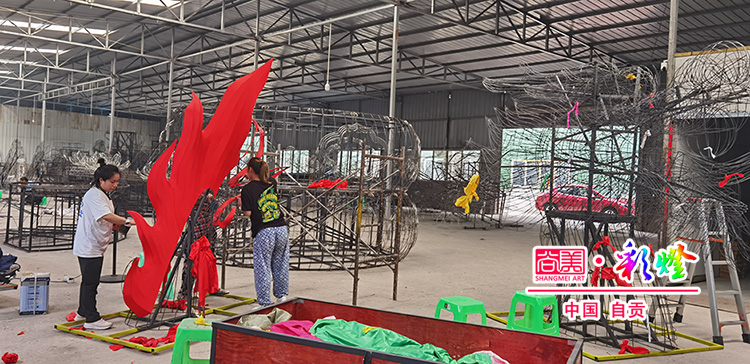
Zigong Shangmei Lantern workshop
Recommended manufacturers of Chinese lanterns (Chinese colored lanterns)
Zigong Shangmei Lantern Art Co., Ltd. is a professional lantern manufacturer specializing in the design and production of lanterns, lantern festivals, lantern exhibitions, and other related events.
Zigong Shangmei Lantern Workshop Operation Corner The company was established in 2013 and has a large number of experienced process technicians. Its core team has been engaged in the lantern industry for nearly 20 years, and in the past, has cooperated with relevant units or enterprises in multiple provinces, cities, and counties in China on numerous lantern projects. Shangmei Lantern Company has a 3500 square meter lantern production workshop, with a wide variety of lantern products, including Spring Lantern Festival, Spring Lantern Festival, Festival Lantern Festival, Craft Palace Lantern, Colorful Chariots and Boats, etc. The company takes it as its responsibility to promote traditional Chinese folk culture, and is committed to developing, utilizing, and processing traditional cultural resources to create a commercial foreign exchange brand enterprise that promotes Chinese traditional folk culture to the world.
In terms of production technology, Shangmei Lantern Company has strict quality control, focusing on details and quality. For example, in the selection of colored light bulbs, they used LED finished string bulbs with low power, sufficient brightness, and good waterproof performance. This type of bulb not only saves electricity costs, but also improves the safety performance of the lantern and reduces the labor cost of production.
The company has also set up a dedicated column to showcase the visual materials of its team during the lantern festival production process, in commemoration of the hard work of team members, and also for peers to learn and exchange ideas with each other. The colorful lantern works produced by him have shone in many festivals, Yuanxiao (Filled round balls made of glutinous rice-flour for Lantern Festival) lantern fairs and temple fairs in the scenic area.
Shangmei Lantern Company has a certain influence and popularity in the field of Zigong lanterns, and its works showcase the exquisite craftsmanship and unique charm of Zigong lanterns. Has rich experience and outstanding performance in the lantern production industry, making positive contributions to the inheritance and development of Zigong lantern culture.





